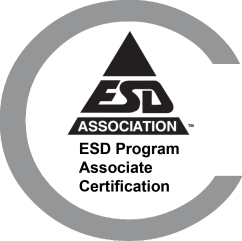-
FC100: ESD Basics
Abstract:
This tutorial provides the foundation material for understanding electrostatics and ESD and the role in the manufacturing and handling of ESD sensitive devices. The fundamental properties of charge, electric fields, voltage, capacitance, and current are discussed to understand key electrostatic phenomena and electrical processes. These include charge generation and decay, material properties, and induction. An overview of device failure mechanisms is presented, including how these models impact ESD control programs. Finally, the course provides an overview of ESD control procedures during handling and manufacturing and an overview of ANSI/ESD S20.20 program requirements. This full-day course is required for those in-plant auditors and program managers working toward professional ESD certification. The presentation includes many in-class demonstrations, videos, and animated slides.
Some sample topics covered in this course are:
Definitions and relationships among important electrical and mechanical properties
Causes of charge generation and decay
Field effects and voltages
Role of capacitance in ESD (Q=CV)
Overview of key measurements including common pitfalls of some measurements
Review of ESD failure models
Understanding and demonstrating electrostatic induction
Utility and limitations of air ionization
Basic goals of ESD controls
Properties of effective ESD control products and materials
Overview of ANSI/ESD S20.20 ESD program development requirements
Learning Outcomes:
Attendees will:
Understand fundamental concepts necessary to manage an ESD Program
Charge Generation
Charge Flow in Materials
Electrostatic Fields and Voltages
Static Induction
Learn about ESD models, test methods and failure modes
Understand important material properties for CDM mitigation
Learn the fundamental elements of an S20.20 program
Discover effective techniques for demonstrating a wide range of ESD fundamentals.
TOC:
Part I
Preliminaries & ESD Definition
Charge Generation
Charge Flow in Materials
Electrostatic Fields and Voltages
Static Induction
Part II
ESD Models and Test Methods
Failure Mode Analysis
Material Properties and Measurements
Ionization
Part III
Implementing the Basics
Demo Equipment Review:
Static Locator
Data Display Device
EMI/ESD Event Detector
Meg Ohmmeter – Resistance System
Metal and Plexiglas Disks
Various Materials
Ionizer
ESD Grounded Mat
Wrist Straps
-
FC101: How To's of In-Plant ESD Auditing and Evaluation Measurements
Abstract:
Compliance verification is one of the most important ESD program management elements, and many technical and administrative pitfalls can be avoided. The attendee will learn how to make valid auditing measurements per ESD TR53 – Compliance Verification of ESD Protective Equipment and Materials and how to recognize and avoid common pitfalls. Common instruments will be explained, and the invalid test results that can result when used incorrectly. Advanced auditing techniques will also be covered that enable Class 0 devices to be handled successfully. There are many ways to administer effective compliance verification programs. Two successful examples will be presented that were developed independently by different companies. Hidden administrative pitfalls that often result in poor compliance will also be discussed. This tutorial will be highly interactive with live demonstrations, in-plant photographs, and compelling video clips. Students will be encouraged to ask questions and to participate in the discussions.
Learning Outcomes:
Attendees will be able to:
Make and correctly interpret essential auditing measurements for ESD programs.
Understand and implement the critical requirements necessary to successfully handle extremely sensitive (Class 0) devices
Avoid common measurement pitfalls and program administrative oversights.
Develop real-world solutions from the review of successful case studies and class discussions
Outline:
Part I - Introduction
Part II -TR53 Compliance Verification Measurements & Troubleshooting
Part III - Measurement Pitfalls
Part IV - Additional Measurements & Troubleshooting
Part V - Examples - CDM & HBM Audit Findings
Part VI - Auditing QMS Strategy Example
Part VII - Advanced Process Assessments and Auditing
-
PRMAFC340: ESD Control Program Development to ANSI ESD S20.20
Abstract:
This class provides instruction on understanding, designing, and implementation techniques for an ESD control program based on ANSI/ESD S20.20.
Introduction:
Understanding Electrostatic Charge & Electrostatic Discharge (ESD)
Device Failure Models (HBM, MM, CDM, FICDM)
ESD Technology Sensitivity Trends
Certification Programs & Assessment Mechanics
Assessments Using the Certification Checklist
Administrative Elements
Technical Elements
ESD Control Program Plan
Learning Outcomes:
Attendees should be able to design, implement, and maintain an effective ESD control program after completing all the Program Manager-related courses. The preference is for students to attend this tutorial last in the Program Manager course sequence when possible. After completing the course curriculum, the attendees should be able to develop an ESD control program plan that fits their company needs and meets industry standards.
